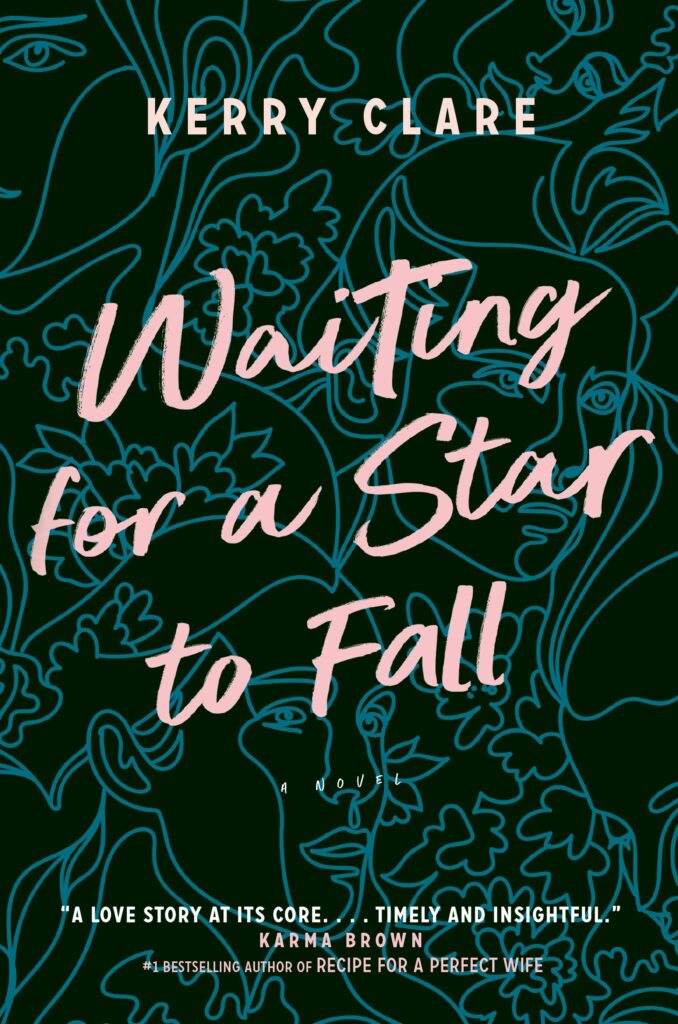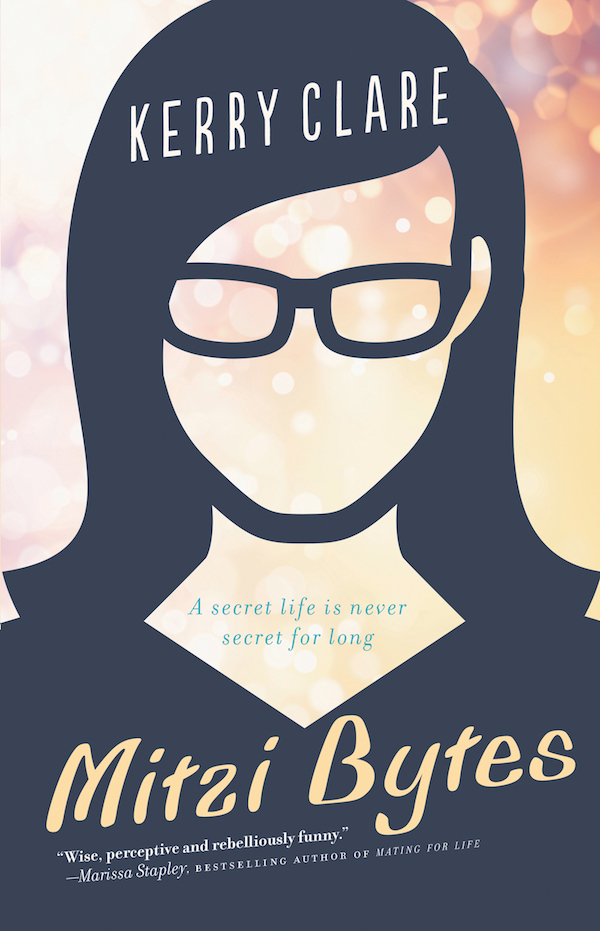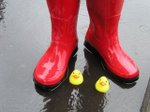October 14, 2010
New kids books we've been enjoying lately
 Bubble Trouble by Margaret Mahy, Illustrated by Polly Dunbar. This book is longer than most that Harriet will sit still for, but I think she gets caught up in the rhythm of the language. Mahy goes to enormous stretches to create her rhymes, resulting in a splendidly absurd vocabulary, all kinds of new words, nonsense rhymes but not so nonsensical, imagine if Dr. Seuss had employed a thesaurus. The story is about a small boy who gets caught up in a bubble blown by his big sister Mabel, and floats up above the town setting his small town into crisis. Soon, the neighbours are all chasing him as he floats, devising ways to bring him down safely. The illustrations are stylish and whimsical, and I particularly delighted in the Scrabble tiles on the page where “In a garden folly, Tybal and his mother, Sybil/ sat and played a game of Scrabble, shouting shrilly as they scored.”
Bubble Trouble by Margaret Mahy, Illustrated by Polly Dunbar. This book is longer than most that Harriet will sit still for, but I think she gets caught up in the rhythm of the language. Mahy goes to enormous stretches to create her rhymes, resulting in a splendidly absurd vocabulary, all kinds of new words, nonsense rhymes but not so nonsensical, imagine if Dr. Seuss had employed a thesaurus. The story is about a small boy who gets caught up in a bubble blown by his big sister Mabel, and floats up above the town setting his small town into crisis. Soon, the neighbours are all chasing him as he floats, devising ways to bring him down safely. The illustrations are stylish and whimsical, and I particularly delighted in the Scrabble tiles on the page where “In a garden folly, Tybal and his mother, Sybil/ sat and played a game of Scrabble, shouting shrilly as they scored.”
 Good Night Canada I’ll admit it, some of these “Good Night…” books stretch the point a bit, but an entire nation is surely enough to fill up a board book, and I like the way that Canada fills up this one. A nice way for Harriet to learn about parts of our country she has never seen, those that are familiar (“Good morning, streetcars of Toronto!”), and that she even lives in a country at all, and one with symbols– maple leaves, the Parliament buildings, hockey, the Canada flag.
Good Night Canada I’ll admit it, some of these “Good Night…” books stretch the point a bit, but an entire nation is surely enough to fill up a board book, and I like the way that Canada fills up this one. A nice way for Harriet to learn about parts of our country she has never seen, those that are familiar (“Good morning, streetcars of Toronto!”), and that she even lives in a country at all, and one with symbols– maple leaves, the Parliament buildings, hockey, the Canada flag.
 Doggy Slippers Written by Jorge Lujan, Illustrated by Isol. At our house we like Isol, who wrote and illustrated It’s Useful to Have a Duck. Doggy Slippers similarly plays games with perspective, providing children with a child’s-eye view upon their own world. Latin American poet Lujan solicited children for poems and stories about pets, and he turned their responses into the poems in this book. Harriet is still too little to get much out of this book, but I adore the poems– “My turtle, Coco, is happy,/ is green,/ is slow,/ except when she falls/ down the stairs.” Isol’s childlike drawings the perfect accompaniment. I look forward to finding out whether these poems make perfect sense to Harriet, filtered through a child’s eyes as they are, or if she detects anything a little “off” about them. They’ll certainly give us a lot to talk about.
Doggy Slippers Written by Jorge Lujan, Illustrated by Isol. At our house we like Isol, who wrote and illustrated It’s Useful to Have a Duck. Doggy Slippers similarly plays games with perspective, providing children with a child’s-eye view upon their own world. Latin American poet Lujan solicited children for poems and stories about pets, and he turned their responses into the poems in this book. Harriet is still too little to get much out of this book, but I adore the poems– “My turtle, Coco, is happy,/ is green,/ is slow,/ except when she falls/ down the stairs.” Isol’s childlike drawings the perfect accompaniment. I look forward to finding out whether these poems make perfect sense to Harriet, filtered through a child’s eyes as they are, or if she detects anything a little “off” about them. They’ll certainly give us a lot to talk about.
 Eats. Written by Marthe Jocelyn. Illustrated by Tom Slaughter. This book is perfect for Harriet’s level, as she recognizes so many of the images that she’ll begin to get the concept. That a giraffe eats leaves, and bears eat fish, and a monkey eats bananas. And then a picture of an ice cream cone, which is Harriet’s favourite food in the world. “And WHO eats ice cream?” Who indeed! Hilarity. We absolutely love this conclusion.
Eats. Written by Marthe Jocelyn. Illustrated by Tom Slaughter. This book is perfect for Harriet’s level, as she recognizes so many of the images that she’ll begin to get the concept. That a giraffe eats leaves, and bears eat fish, and a monkey eats bananas. And then a picture of an ice cream cone, which is Harriet’s favourite food in the world. “And WHO eats ice cream?” Who indeed! Hilarity. We absolutely love this conclusion.
 C is for Coco: A Little Chick’s First Book of Letters. Written by Sloane Tanen, Photographed by Stefan Hagen. We love this book! I appreciate alphabet books that include some of our favourite words, like dancer, apple, umbrella and penguin. And good new ones too, for educational purposes (ie “elbow”). The chick is cute and fun, Tanen’s dioramas are adorable, and some of the rhymes aren’t totally brilliant, I’ll forgive them. Harriet likes this book as much as I do, and we’re not sick of it yet.
C is for Coco: A Little Chick’s First Book of Letters. Written by Sloane Tanen, Photographed by Stefan Hagen. We love this book! I appreciate alphabet books that include some of our favourite words, like dancer, apple, umbrella and penguin. And good new ones too, for educational purposes (ie “elbow”). The chick is cute and fun, Tanen’s dioramas are adorable, and some of the rhymes aren’t totally brilliant, I’ll forgive them. Harriet likes this book as much as I do, and we’re not sick of it yet.
 No. By Claudia Rueda. The book begins with Little Bear’s mother urging him (or her?) to begin preparing for winter, and Little Bear responds with all those familiar excuses. He’s not tired, and he wants to play, and no matter that it’s getting cold– he loves the cold! And with every page, winter gets a bit closer. Soon there is no sign of anyone but Little Bear, and the snow is falling fast and mean– perhaps Little Bear has overestimated his own stamina? When he finds his mother again, he tells he he’s back because he thought she might get lonely without him. But is he telling the truth, we ask ourselves each time we reach this book’s end? It’s a gorgeously illustrated book, with drawings from interesting points of view, and Harriet likes finding Little Bear in the pictures as the snow falls harder and he becomes more difficult to see.
No. By Claudia Rueda. The book begins with Little Bear’s mother urging him (or her?) to begin preparing for winter, and Little Bear responds with all those familiar excuses. He’s not tired, and he wants to play, and no matter that it’s getting cold– he loves the cold! And with every page, winter gets a bit closer. Soon there is no sign of anyone but Little Bear, and the snow is falling fast and mean– perhaps Little Bear has overestimated his own stamina? When he finds his mother again, he tells he he’s back because he thought she might get lonely without him. But is he telling the truth, we ask ourselves each time we reach this book’s end? It’s a gorgeously illustrated book, with drawings from interesting points of view, and Harriet likes finding Little Bear in the pictures as the snow falls harder and he becomes more difficult to see.
August 25, 2010
Notables: The Little Mother Goose
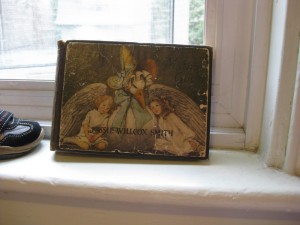 Though I collect books, I am by no means a Book Collector, because most of my books are battered paperbacks that Penguin put out in the ’70s. I do, however, have some notable exceptions in my library, which are by no means valuable or rare, but they still possess a certain kind of charm. And so these books will be the subject of a new Pickle Me This feature, which I have just entitled Notables.
Though I collect books, I am by no means a Book Collector, because most of my books are battered paperbacks that Penguin put out in the ’70s. I do, however, have some notable exceptions in my library, which are by no means valuable or rare, but they still possess a certain kind of charm. And so these books will be the subject of a new Pickle Me This feature, which I have just entitled Notables.
The first notable is The Little Mother Goose by Jessie Wilcox Smith, and the first cool thing about this book is that it’s available in its entirety as a Project Gutenbergy eBook, whose pictures are sharper than those in my book, which is points for digitization. My book doesn’t have hyperlinks either.
My book, however, unlike the digital version, is almost ninety years old, and is inscribed (in ink that hasn’t even faded), “To Helen on her fifth birthday. from Mama.” Helen is my late-grandmother, and her mother died when she was eight years old. My mother, who is Helen’s daughter, had the book rebound, and gave it to me for Christmas two years ago when I was pregnant with Harriet.
(The power of book as object [or I suppose the power of object in general, of relic] is underlined by what I find in my great-grandmother’s letters, which I have a collection of. On a whim, I just opened it to April 16, 1923, and found this: “My dear Susie, This is Helen’s birthday and she had quite a glorious time. She started kindergarten last week but I didn’t let her go today as she had quite a cold and I thoguht maybe she was developing measles…/ Your brass jardinier came long ago. She is very fond of it and spent about a half hour polishing it today. Other gifts she received were- A pair of gloves from Daddy/ A Child’s Garden of Verses by Stevenson from Clara…/ Skipping rope from James/ The Little Mother Goose illustrated by Jessie Wilcox Smith from Mama and a hankie from little Hazel Keenan who was here for tea. I made a lovely angel cake and of course it had candles, Mother brought ice cream for a treat too. So the child had quite an exciting day altogether.”
Indeed, as Tom Stoppard wrote in Arcadia, “We shed as we pick up, like travellers who must carry everything in their arms, and what we let fall will be picked up by those behind…” Though I wonder what happened to the hankie or the jardinier. I imagine the cake was devoured…)
Anyway, I’m way off track. In addition to its beautiful illustrations, this book is full of nursery rhymes you’ve never ever heard of, and the proportional few that you have.
Like, “Pickeleem, pickleem, pummis-stone! What is the news, my beautiful one? My pet doll-baby, Frances Maria, Suddenly fainted and fell in the fire; The clock on the mantle gave the alarm,/ But all we could save was one china arm.” And that little-known second verse to Jack and Jill: “Up Jack got and home did trot, As fast as he could caper; Dame Jill had the job to plaster his knob, With vinegar and brown paper.” Um, yes.
A few rhymes referencing something called “Chop a nose day.”
And many riddles, including “A riddle, a riddle, I suppose. A hundred eyes and never a nose.” (Answer: a cinder-sifter). I probably wouldn’t have got that one.
August 16, 2010
On Literary Maps
 Some books I’ve finished lately (Galore anybody?), I put down and think, “My god, if only the text had come with an accompanying map.” Now granted, an author should set the scene so vividly that the map is drawn with words, but for me, there is something so mesmerizing about actual maps in books. As a child, I would actually play with them, imagining characters’ ways along rivers and roads. As an adult reader, I just find them beautiful, and appreciate the extra layer of experience they add to the book. I am also a bit obsessed with fiction with appendices, as a postmodern quirk.
Some books I’ve finished lately (Galore anybody?), I put down and think, “My god, if only the text had come with an accompanying map.” Now granted, an author should set the scene so vividly that the map is drawn with words, but for me, there is something so mesmerizing about actual maps in books. As a child, I would actually play with them, imagining characters’ ways along rivers and roads. As an adult reader, I just find them beautiful, and appreciate the extra layer of experience they add to the book. I am also a bit obsessed with fiction with appendices, as a postmodern quirk.
I perused my library tonight to select some books with maps inside. The House at Pooh Corner was an obvious choice, with the “100 Aker Wood” map, which includes (of course), “the place where the wozzle wasn’t”. This was one of the fictional maps that Joan Bodger and family attempted locate in reality in How the Heather Looks, along with the map from Swallows and Amazons.
My lovely Snowbooks edition of Virginia Woolf’s The London Scene has a charming map of London in the front endpapers, with drawings of all the landmarks noted by Woolf in her essays. The back endpapers is London on a different scale, with Woolf’s own residences noted (22 Hyde Park Gate!).
Will Ferguson’s Hokkaido Highway Blues has a somewhat unremarkable map on Japan just inside the cover, but without it we wouldn’t quite get the weight of the fact that Ferguson travelled the country from tip-to-tip. I bought this book just before we moved in Japan in 2004, to the city of Himeji, which made the sub-map on page 148 very remarkable, because the map shows that Ferguson made Himeji a stop along his way. “At Himeji Castle, the flowers were in full bloom and everywhere there was activity and laughter.”
Hobart 8 wears its map on its cover. I bought it at City Lights Books in 2008 because it was beautiful and contained a story by 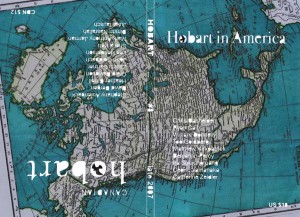 Stephany Aulenback, and I have a vivid memory of reading the whole thing on the green grass of Dolores Park (in February!). The southernmost half of the issue is American writers, North is Canadian whose lineup was pretty much unknown to me at the time but they’re writers who’ve been pretty much everywhere since– Heather Birrell, Craig Davidson, Zsuzsi Gartner, Lee Henderson, and Mark Anthony Jarman. I saw them here first. Map is by Robert Waters.
Stephany Aulenback, and I have a vivid memory of reading the whole thing on the green grass of Dolores Park (in February!). The southernmost half of the issue is American writers, North is Canadian whose lineup was pretty much unknown to me at the time but they’re writers who’ve been pretty much everywhere since– Heather Birrell, Craig Davidson, Zsuzsi Gartner, Lee Henderson, and Mark Anthony Jarman. I saw them here first. Map is by Robert Waters.
Patricia Storms’ The Pirate and the Penguin is delightful all over, but my favourite corners are the maps on her endpapers. “Map of the really boring (and cold!) South Pole” on the first endpapers, with such landmarks as Chilly Cove and Yawny Yogaland. “Map of the hot and itchy Caribbean” is on the back, with “Drives Me Coconuts Island” and a chest of “Boring Treasure”. Love it.
Though the first literary map I gave my heart to was in The Long Secret by Louise Fitzhugh. A map of Water Mill, where Harriet Welch is spending the summer with Beth Ellen, I was totally obsessed with this one, and I’m sure why because it’s pretty sparsely detailed, but I suspect the particular hand of Fitzhugh herself may have something to do with it.
My copy of Andrea Barrett’s story collection Servants of the Map is chock-full of images, and it’s unsurprising that a map would be one of them (along with gorgeous drawings of wildlife and taxonomic classifications). The title story is illustrated with “Sketch Map to accompany the Geological Notice of Kashmir”.
A map in a poetry collection! I was thrilled to find a vintage guide map to Los Alamos in Michael Lista’s Bloom.
And finally, Annie Dillard’s An American Childhood has for its endpapers “Pittsburgh about 1800”, even though Dillard’s book is about Pittsburgh in the mid-twentieth century, but Annie Dillard is always tricky, isn’t she?
Though I can’t finish without a mention of the map in Janice Kulyk Keefer’s The Ladies’ Lending Library. Which doesn’t even exist, but I was convinced it did, and leafed through the book about five times tonight looking for it. And that I haven’t read the story for a few years, but its managed to leave a map emblazoned upon my mind is really quite a testament to Kulyk Keefer’s depiction of place.
July 29, 2010
Imagine a place
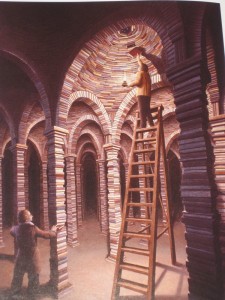 Yesterday Harriet crawled around the library lusting after other children’s nannies, and so I sat idly by the picture book shelf to see what I could see. My favourite discovery was Imagine a Place by Sarah L. Thomson, but in particular, the images by Rob Gonsalves. Amazing, mesmerizing pictures that become more magical the longer you look.
Yesterday Harriet crawled around the library lusting after other children’s nannies, and so I sat idly by the picture book shelf to see what I could see. My favourite discovery was Imagine a Place by Sarah L. Thomson, but in particular, the images by Rob Gonsalves. Amazing, mesmerizing pictures that become more magical the longer you look.
July 25, 2010
What I expected
 Harriet (aged 14 months) likes teacups, Miffy, and books, and so my job here is basically done. And though she’s changing all the time (starting to walk, starting to talk!), her recent engagement with books has been particularly fascinating. She’s started to make real connections between the books we read and the actual world, pointing out dogs within pages as she does on the sidewalk. When we pull out Hand Hand Finger Thumb, she goes to get her own drum off her shelf so she can play along with the monkeys. We’re rereading The House at Pooh Corner at the moment, and she points up at her mobile when she hears Pooh’s or Piglet’s name. When we read Kisses Kisses Baby-O by Sheree Fitch, and get to the “slurpy, burpy” page, she starts pointing to her breastfeeding pillow. When we read Ten Little Fingers, Ten Little Toes, she shows us all the appropriate digits. Tonight when we read Goodnight Gorilla (on the occasion of a trip to the zoo) she went insane, but I think that was only because she was tired.
Harriet (aged 14 months) likes teacups, Miffy, and books, and so my job here is basically done. And though she’s changing all the time (starting to walk, starting to talk!), her recent engagement with books has been particularly fascinating. She’s started to make real connections between the books we read and the actual world, pointing out dogs within pages as she does on the sidewalk. When we pull out Hand Hand Finger Thumb, she goes to get her own drum off her shelf so she can play along with the monkeys. We’re rereading The House at Pooh Corner at the moment, and she points up at her mobile when she hears Pooh’s or Piglet’s name. When we read Kisses Kisses Baby-O by Sheree Fitch, and get to the “slurpy, burpy” page, she starts pointing to her breastfeeding pillow. When we read Ten Little Fingers, Ten Little Toes, she shows us all the appropriate digits. Tonight when we read Goodnight Gorilla (on the occasion of a trip to the zoo) she went insane, but I think that was only because she was tired.
It’s all very exciting though, partly because there was once a time when Harriet was about as engaging as a wall. But mostly because I love books and she seems to like them too, and they’re such a wonderful thing for us to enjoy together. It’s the one of the few illusions I had pre-motherhood that has turned out exactly as I’d expected.
July 23, 2010
To get to Faulkner, start with Nancy Drew
“Parents didn’t have to read the New York Review of Books or James Joyce, and they didn’t have to make their kids read Treasure Island or Greek Myths. Parents simply had to read for themselves, and to make sure there were kids’ books in the house. Children had only to see that reading was something adults did for pleasure and, following this example, would begin to read on their own.
…What were her most important books? Nancy Drew mysteries, Gone With the Wind, and a hulking anthology, Twenty Five Tales of the Weird and Supernatural. Not Faulkner, not Proust, but Nancy Drew; the first rungs on the ladder are often the most daring. To get to Faulkner, start with Nancy Drew. Or books about horses. Books by Kurt Vonnegut, or Ayn Rand, or A Wrinkle in Time, or On the Road, or To Kill a Mockingbird, or Goosebumps. It’s entirely possible that some of tomorrow’s voracious readers will cite the Harry Potter novels as important, but just as many might cite a novel not found in every house on the planet.”–From The Yellow Lighted Bookshop by Lewis Buzbee
June 29, 2010
Good news about bedtime reading
Though I’m not sure I qualify as a “busy parent”*, I am excited that Harriet and I appear (with a picture!) in this lovely piece by Andrea Gordon in The Toronto Star about bedtime reading. The article was written in response to a recent study showing that 88% of parents with kids under twelve read regularly to their children at bedtime. Which is good news, in addition to the news that all of us knew already– that bedtime reading is one of parenthood’s great pleasures.
*I am not being self-deprecating. Most of this morning has been spent either in a slanket or lying on the floor.
June 24, 2010
Goodness turnips!
 I have a vivid memory of the day my mother bought me a copy of Pollyanna on a visit to The World’s Biggest Bookstore when I was about eight years old. (This was back when TWBB was my favourite place in the universe.) I must have read the book a few times because many parts of it have stayed with me, but what I remember the most is the afterword to my edition, which was written by the great Lois Lowry. What I remember is one phrase in particular, one that applies to most of the books I like best; I think of it today because I’m currently rereading February by Lisa Moore.
I have a vivid memory of the day my mother bought me a copy of Pollyanna on a visit to The World’s Biggest Bookstore when I was about eight years old. (This was back when TWBB was my favourite place in the universe.) I must have read the book a few times because many parts of it have stayed with me, but what I remember the most is the afterword to my edition, which was written by the great Lois Lowry. What I remember is one phrase in particular, one that applies to most of the books I like best; I think of it today because I’m currently rereading February by Lisa Moore.
The phrase is, “Goodness triumphs; I like that.” Except that I didn’t know the word “triumphs” when I was eight years old, and I read it as “turnips”. I read the whole phrase as a kind of exclaimation similar to “Goodness gracious” or “Merciful heavens”, but with a root vegetable twist.
“Goodness turnips; I like that.”
And all these years later, I still do.
June 6, 2010
Does one seek escape in children's classics because one is miserable?
 One year I received Swallows and Amazons for Christmas, and I was furious, because I’d wanted Goodbye, Stacey. Goodbye. I grew up reading Archie comics and The Sleepover Friends and This Can’t Be Happening at MacDonald Hall. Apart from an obligatory obsession with L.M. Montgomery and a passing fancy with Frances Hodgson Burnett, I didn’t read much in the line of classics. Or rather, though I did read classic books, they weren’t the ones that captured me. I think I was also too busy watching one sitcom after another during the hours after school.
One year I received Swallows and Amazons for Christmas, and I was furious, because I’d wanted Goodbye, Stacey. Goodbye. I grew up reading Archie comics and The Sleepover Friends and This Can’t Be Happening at MacDonald Hall. Apart from an obligatory obsession with L.M. Montgomery and a passing fancy with Frances Hodgson Burnett, I didn’t read much in the line of classics. Or rather, though I did read classic books, they weren’t the ones that captured me. I think I was also too busy watching one sitcom after another during the hours after school.
When I read Joan Bodger’s wonderful book How the Heather Looks, I became conscious of how much I’d missed. I’ve only read A.A. Milne during the past year, Lewis Carroll has also come late to me, my Beatrix Potter was pretty rudimentary, I turned my nose up a Arthur Ransome, I only read Peter Pan as an adult, I preferred The Littles to The Borrowers, and I wouldn’t know The Wind in the Willows if it knocked me over. Part of this, of course, is that I’m not British, but I still couldn’t help but think I’d missed something. Reading about how real the worlds of these books were to Bodger’s children filled me with a kind of longing for a storybook childhood of my own, and then a compulsion to pass one onto my child instead to make up for all that I’d lacked.
I’ve since learned more about Joan Bodger’s children though, and the tragedy their family endured. I wonder how much of Ian’s encyclopedic knowledge of stories, and history, and imagined lands had to do with his own troubles, and the particular quirks of his brain that would so challenge him as he grew older. I read Bodger’s second memoir The Crack in the Teacup, and learned of the solace she found in children’s stories during lonely times in her own youth. About how she wanted friends to go play Swallows and Amazons with, but the other girls her age were obsessed with boys and lipstick. And of course all this made me want to reference the great Nick Hornby– does one seek escape into children’s classics because one is miserable, or is one miserable because one seeks escape in children’s classics?
What I’m really asking, of course, is that if I come home with a copy of The Wind in the Willows, will Harriet grow up to have no friends? Could my idiotic literary preoccupations in youth be symptomatic of my fairly happy childhood?
May 29, 2010
The Birthday Haul
 We were inspired by Carrie Snyder and her gift-free birthday idea, because our apartment is small, the planet’s resources are limited, plastic lives forever, and Harriet already has a lot of stuff. And because we had every intention of spoiling her ourselves, of course, as did the rest of our families. But we wanted to celebrate Harriet’s first birthday with our friends as well, so when we invited them to the birthday party, we asked that lieu of gifts, they bring a board book for donation to The Children’s Book Bank.
We were inspired by Carrie Snyder and her gift-free birthday idea, because our apartment is small, the planet’s resources are limited, plastic lives forever, and Harriet already has a lot of stuff. And because we had every intention of spoiling her ourselves, of course, as did the rest of our families. But we wanted to celebrate Harriet’s first birthday with our friends as well, so when we invited them to the birthday party, we asked that lieu of gifts, they bring a board book for donation to The Children’s Book Bank.
I know that the Book Bank is in need of board books in particular, and now that I know Harriet, I understand why. Board books are basically edible, which doesn’t bode well for second-hand. And did our friends ever deliver– check out this stack of goods. How wonderful to spend a beautiful afternoon in such splendid company, and have this to show for it. It also gives us an excellent excuse to make a trip to the Book Bank ourselves, because it’s really a magical place.

